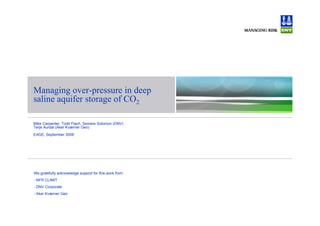More Related Content Similar to Presentation_Budapest_EAGE_Sep_2008 Similar to Presentation_Budapest_EAGE_Sep_2008 (20) 1. Managing over-pressure in deep
saline aquifer storage of CO2
Mike Carpenter, Todd Flach, Semere Solomon (DNV)
Terje Aurdal (Aker Kværner Geo)
EAGE, September 2008
We gratefully acknowledge support for this work from:
- NFR CLIMIT
- DNV Corporate
- Aker Kværner Geo
2. © Det Norske Veritas AS. All rights reserved Slide 201 December 2008
Fracturing of caprock
Capillary entry pressure of caprock exceeded
Migration along/across faults
Abandoned wells compromised
Wide pressure pulse and area of impact
Motivation
Many potential storage formations will have their capacity
constrained by the increase in reservoir pressure caused by
injection
In addition a number of risk factors will become more likely
with higher formation pressures:
3. © Det Norske Veritas AS. All rights reserved Slide 301 December 2008
Motivation
EU Commission, January 2008:
“storage complex means the storage site and surrounding
geological domains which can have an effect on overall
storage integrity and security (i.e., secondary containment
formations)”
Environment Protection Agency, July 2008:
“The confining system should be of sufficient regional
thickness and lateral extent to contain the entire CO2 plume
and associated pressure front under the confining system
following the plume’s maximum lateral expansion”
Simulate reduction in peak reservoir pressure by
utilising secondary containment formations
4. © Det Norske Veritas AS. All rights reserved Slide 401 December 2008
Injection well flow rate = 500,000 Sm3/day
(for 40yrs = 14.5 Mt total)
Choice of model
Reservoir
Caprock
Reservoir
Injection point
R = 3500 m, h = 10 m
Top of model = 750 m depth
Kv = 100 mD, Kh = 200 mD
Porosity = 0.15
Cell size = 175 x 175 x 10 m
5. © Det Norske Veritas AS. All rights reserved Slide 501 December 2008
Model permeability
Depth
750 m
850 m
900 m
1000 m
Reservoir
(100 mD)
Caprock
(0.0005 mD)
Reservoir
(100 mD)
Migration pathway
(0.05 mD)
Injection point
Colour scheme indicates permeability
6. © Det Norske Veritas AS. All rights reserved Slide 601 December 2008
100yrs
250yrs
500yrs
1000yrs
Top of structure @ 750 m depth
CO2 molality - injection only
Mol/kg
7. © Det Norske Veritas AS. All rights reserved Slide 701 December 2008
CO2 molality - with brine production
100yrs
250yrs
500yrs
1000yrs
Top of structure @ 750 m depth
Mol/kg
8. © Det Norske Veritas AS. All rights reserved Slide 801 December 2008
Top of structure @ 750 m depth
CO2 molality - with brine re-injection
250yrs
500yrs
1000yrs
100yrs Mol/kg
9. © Det Norske Veritas AS. All rights reserved Slide 901 December 2008
Pressure(kPa)
Initial pressure
Pressure vs. time
- single cell at top of deep aquifer
Deep + shallow aquifers
- and re-injection
- with brine production
Time (yr)
10. © Det Norske Veritas AS. All rights reserved Slide 1001 December 2008
Global CO2 dissolution rates
Deep + shallow aquifers
- with brine production
- and re-injection
Pressure effects from brine production and re-injection re-align the CO2 plume,
but little net change in dissolution
Supercritical CO2
Dissolved CO2
11. © Det Norske Veritas AS. All rights reserved Slide 1101 December 2008
What happens to produced brine?
Will depend on salinity and chemical composition
Offshore
- released into the sea
Onshore
- re-circulation to shallower formations may be an option
- source of potable water if de-salination possible
- potential source of coolant to powerstations in water stressed areas
- low salinity brackish waters suitable for some agriculture purposes
(Dwarf glasswort grows well at 70 g/l of dissolved solids, and may be
useful as a crop. Plants such as barley and the date palm can tolerate
about 5 g/l)
12. © Det Norske Veritas AS. All rights reserved Slide 1201 December 2008
Conclusions
CO2 storage performance is a geosphere issue and can
benefit from using more than just one aquifer and caprock
Proposed EU legislation permits definition of a “storage
complex” with more than one storage formation
Dispersion of the pressure pulse in more than one storage
formation will limit the lateral extent of the pressure front and
decrease risk exposure
13. © Det Norske Veritas AS. All rights reserved Slide 1301 December 2008
Questions?
14. © Det Norske Veritas AS. All rights reserved Slide 1401 December 2008
Grid cell permeability in the caprock is reduced in order to simulate a
generalised CO2 migration pathway (leaky well, fault zone)
General migration pathway
1 m wide pathway @ 10mD
175m
10m
Caprock
(0.0005 mD)
1m
Caprock
(0.0005 mD)
Cell size = 175 x 175 x 10 m
Fracture size = 1x 175 x 10 m
Simple averaging gives:
((0.0005*174)+(10*1))/175 = 0.06 mD
Rounded down to 0.05 mD in model
CO2
15. © Det Norske Veritas AS. All rights reserved Slide 1501 December 2008
Sensitivity tests for grid cell size
CO2 molality
after 500 yrs
300x300x60 m
200x200x20 m 100x100x5m
300x300x15 m
Plot global rate
of disolution
to see effects
of numerical
dispersion…
16. © Det Norske Veritas AS. All rights reserved Slide 1601 December 2008
Medium (i,j = 200m)
Fine (i,j = 100m)
Coarse (i,j = 300m)
h/v ratio = 20:1
h/v ratio = 10:1
h/v ratio = 5:1
Sensitivity tests for grid cell size
1200 x 1200 x 300m (0.432km3)
Top of model depth = 900 m
Kv = 100mD, Kh = 200 mD, Porosity = 0.15
Injection rate = 12,500 m3/day for 40yrs (0.36Mt total)
Inventory plot for global SC CO2 vs. time (yrs)
200 x 200 x 10 m
Reduced to
175 x 175 x 10 m
In model
